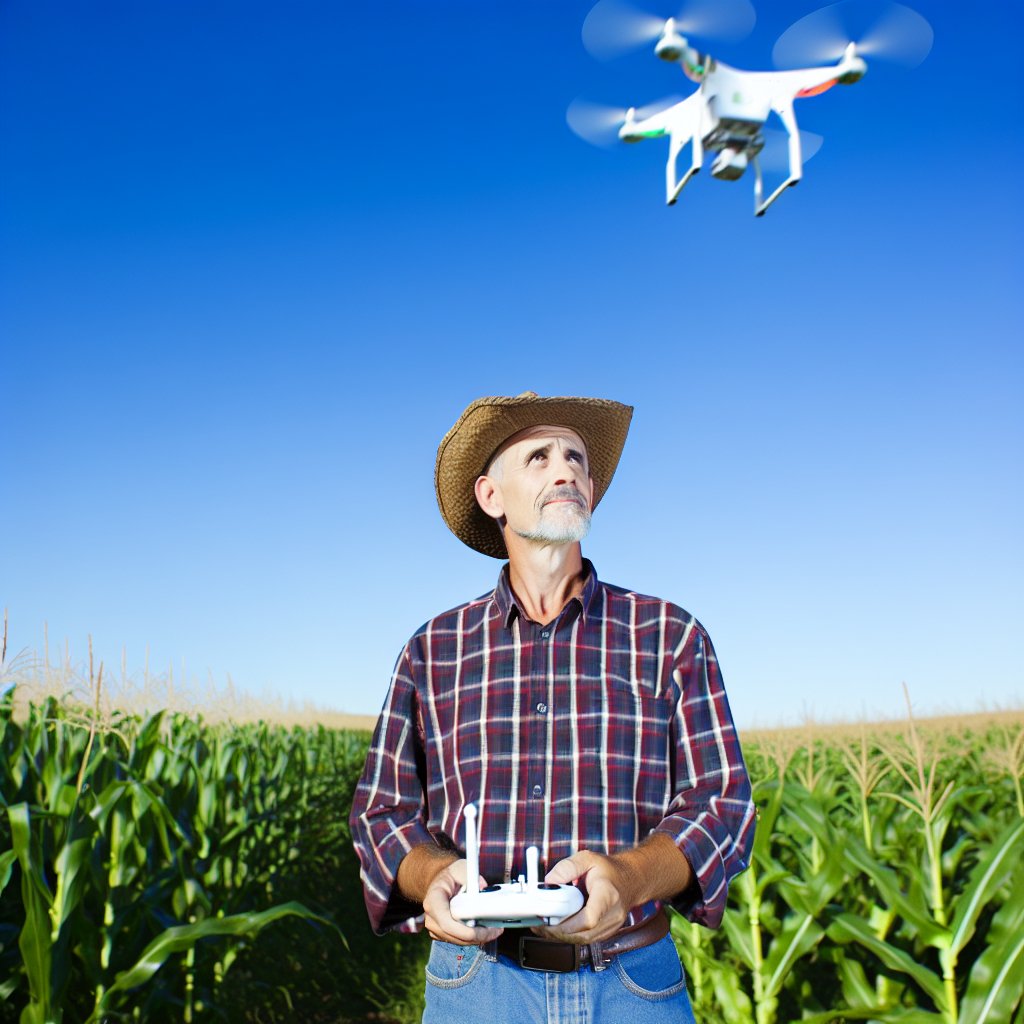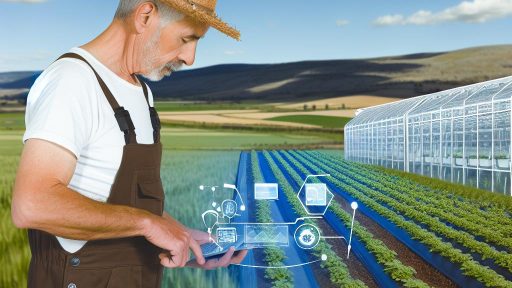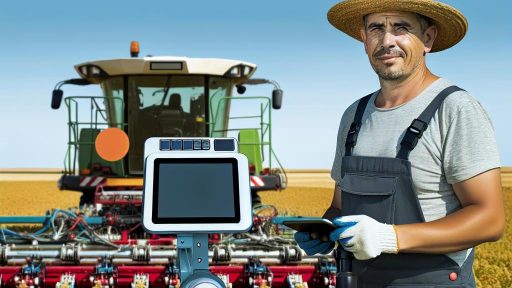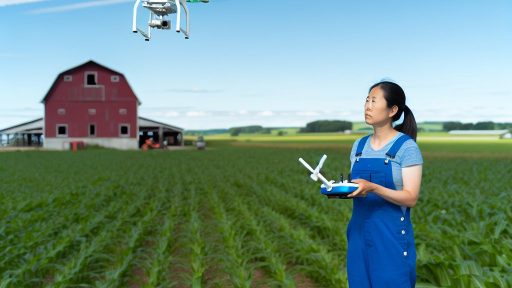Introduction to Drones in Agriculture
Overview and Benefits
Drones are transforming modern agriculture in significant ways.
Farmers increasingly adopt drone technology for various tasks.
These devices enhance efficiency and precision in farming operations.
They help in monitoring crops, mapping fields, and managing resources.
Additionally, drones assist in pest control and irrigation management.
Increased Efficiency
Using drones saves farmers valuable time and labor.
They can cover large areas quickly and provide detailed insights.
This speed allows farmers to make timely decisions.
Moreover, drones reduce the need for human labor in certain tasks.
Enhanced Data Collection
Drones collect high-resolution images of fields.
These images reveal crop health and growth patterns easily.
Farmers can analyze data to identify areas needing attention.
This analysis leads to more informed management practices.
Cost-Effectiveness
Investing in drone technology can reduce overall farming costs.
Farmers experience savings in labor and resource management.
Transform Your Agribusiness
Unlock your farm's potential with expert advice tailored to your needs. Get actionable steps that drive real results.
Get StartedOver time, the return on investment can be substantial.
This technology also aids in precise application of fertilizers and pesticides.
Environmental Sustainability
Drones contribute to sustainable farming practices.
They enable precise monitoring to limit chemical usage.
Farmers can apply resources only where needed, minimizing waste.
This targeted approach supports environmental conservation efforts.
Accessibility and Ease of Use
Modern drones are becoming more user-friendly each year.
Farmers can operate them with minimal training.
Many models come with automated features and easy controls.
This accessibility empowers more farmers to utilize this technology.
Types of Drones Used in Agriculture
Fixed-wing Drones
Fixed-wing drones glide efficiently over large areas.
They cover more ground in less time compared to other types.
This makes them ideal for large farming operations.
These drones often have longer flight times and faster speeds.
Additionally, they can carry heavier payloads than multi-rotors.
Fixed-wing drones are commonly used for mapping and surveying fields.
Multi-rotor Drones
Multi-rotor drones offer precise maneuverability for targeted tasks.
They are perfect for small-scale farms and detailed inspections.
These drones can take off and land vertically, providing versatility.
They are excellent for crop spraying applications.
Furthermore, they can capture high-resolution images from various angles.
This capability aids in detailed assessments of crop health.
Comparing Fixed-wing and Multi-rotor Drones
Both types of drones serve unique purposes in agriculture.
Farmers should consider their specific needs when choosing a drone.
Showcase Your Farming Business
Publish your professional farming services profile on our blog for a one-time fee of $200 and reach a dedicated audience of farmers and agribusiness owners.
Publish Your ProfileFor large areas, fixed-wing drones often prove more efficient.
In contrast, multi-rotor drones excel in precision tasks.
Both drone types can significantly enhance farming efficiency.
As technology evolves, farmers can look forward to more options.
How Drones Can Improve Crop Monitoring and Yield Assessment
Enhancing Crop Monitoring
Drones offer real-time aerial surveillance of fields.
This allows farmers to track crop health effectively.
Firstly, drones capture high-resolution images.
These images reveal critical data on plant stress.
Secondly, drones utilize multispectral cameras.
This technology detects variations in plant health.
Farmers can identify nutrient deficiencies timely.
Moreover, drones can cover large areas quickly.
This significantly reduces the time spent monitoring crops.
Improving Yield Assessment
Drones facilitate accurate yield predictions.
They collect data on crop density and growth stages.
Additionally, drones assess moisture levels in soil.
This information leads to better irrigation strategies.
Farmers can adjust their practices according to findings.
Consequently, they improve overall crop yield.
Lastly, drones assist in post-harvest evaluations.
This data helps optimize future planting strategies.
Cost-effectiveness and Efficiency
Using drones can reduce labor costs significantly.
They minimize the need for manual scouting.
Additionally, drone technology can save resources.
Accurate assessments lead to better resource allocation.
Farmers waste less water and fertilizers this way.
Ultimately, this enhances environmental sustainability.
Learn More: Precision Agriculture Software Optimizing Sustainable Farm Management
Using Drones for Precision Agriculture
Overview of Drone Technology
Drones have transformed the landscape of agriculture.
They enable farmers to monitor vast fields efficiently.
Through aerial imagery, drones provide valuable data.
Farmers can assess crop health and soil conditions.
Moreover, they facilitate timely decision-making.
Techniques for Utilizing Drones
Farmers can use drones for multiple applications.
These include crop mapping, soil analysis, and irrigation management.
Additionally, they assist in pest and disease detection.
Farmers should adopt high-resolution imaging techniques.
This technique allows for accurate assessment of crop canopy.
Crop Mapping
Drones can create detailed maps of fields.
They gather information on crop variability efficiently.
Showcase Your Farming Business
Publish your professional farming services profile on our blog for a one-time fee of $200 and reach a dedicated audience of farmers and agribusiness owners.
Publish Your ProfileThis data aids in targeted crop management practices.
Soil Analysis
Using thermal imaging, drones evaluate soil moisture levels.
This analysis helps farmers optimize irrigation strategies.
Furthermore, it contributes to efficient water usage.
Benefits of Drone Technology in Farming
Drones offer numerous advantages to farmers.
They can increase crop yields significantly.
Also, they reduce labor costs and time spent on tasks.
Farmers experience improved precision in agricultural practices.
The overall result is enhanced sustainability in farming.
Cost-Effectiveness
Investing in drone technology proves cost-effective over time.
The initial investment pays off through increased productivity.
Farmers see a reduction in resource wastage as well.
Environmental Impact
Drones contribute to more environmentally friendly practices.
They minimize the use of pesticides and fertilizers.
This technology promotes better land management solutions.
Integration of Drone Data with Other Technologies
Drones can integrate seamlessly with other digital tools.
For instance, they work well with GIS systems.
Farmers can create robust data analysis platforms.
This integration supports comprehensive farm management.
Data Collection and Analysis
Farmers can collect real-time data using drones.
They can analyze this data to make informed decisions.
This process enhances operational efficiency and effectiveness.
Vertical Farming Synergy
Drones can also support vertical farming techniques.
They monitor urban farming operations efficiently.
This synergy maximizes space and productivity in cities.
You Might Also Like: Optimizing Farm Operations Through IoT Technologies
Regulations and Compliance for Drone Usage in Farming
Understanding the Legal Framework
Farmers must understand the regulations governing drone usage.
Familiarity with local and national laws is crucial.
Regulations often focus on airspace, safety, and privacy.
Federal Aviation Administration Guidelines
The Federal Aviation Administration (FAA) oversees drone operations in the U.S.
Farmers should obtain a Remote Pilot Certificate to operate drones commercially.
This certification requires passing a knowledge test and meeting specific conditions.
State-Specific Regulations
Each state may have unique drone laws and requirements.
Farmers should check their state’s regulations before using a drone.
Local restrictions could impact where and how drones can be flown.
Privacy and Property Rights
Drone usage raises privacy concerns that farmers must address.
Respecting the privacy of neighbors is essential while flying drones.
Farmers should understand property rights related to airspace access.
Operational Safety Guidelines
Following operational safety guidelines reduces accidents.
Farmers should maintain a safe distance from people and structures.
Showcase Your Farming Business
Publish your professional farming services profile on our blog for a one-time fee of $200 and reach a dedicated audience of farmers and agribusiness owners.
Publish Your ProfileRoutine maintenance checks on drones ensure they operate effectively.
Additionally, staying updated on weather conditions is vital for safety.
Insurance and Liability Considerations
Farmers should consider obtaining insurance for drone operations.
Insurance can mitigate financial risks associated with accidents.
Understanding liability laws protects farmers from potential claims.
Staying Informed
Regulations may change, so staying informed is crucial.
Farmers can join local agricultural organizations for updates.
Engaging in drone-related training enhances knowledge of best practices.
Find Out More: Implementing AI And Machine Learning In Crop Disease Detection Systems

Case Studies: Successful Applications of Drones in Various Farm Types
Cereal Crops
Drones significantly enhance the management of cereal crops.
A notable case is the use of drones in wheat fields in Nebraska.
Farmers utilized drones for crop monitoring and health assessment.
Subsequently, they detected diseases early, preventing losses.
This proactive approach improved overall yield and quality.
Fruit Orchards
Drones also thrive in fruit orchard applications.
Consider the example of apple orchards in Washington State.
Drones assisted in monitoring blossom times and health status.
Farmers achieved optimized pollination and reduced waste.
Moreover, this technique allowed for more precise pesticide application.
Vegetable Production
In vegetable farming, drones cater to various needs.
A successful illustration involves lettuce farms in California.
Drones provided insight into soil moisture levels across fields.
This data enabled efficient irrigation scheduling.
As a result, water usage significantly decreased while maintaining yields.
Paddy Fields
Drones play a crucial role in managing paddy fields as well.
An inspiring application occurred in rice production in Thailand.
Drones facilitated the assessment of water levels and crop health.
This information improved irrigation efficiency and minimized flooding.
Farmers reported enhanced productivity through timely interventions.
Livestock Monitoring
Beyond crops, drones offer valuable benefits in livestock management.
Take the case of cattle ranchers in Texas, for instance.
Drones helped monitor the location and health of herds.
This real-time data allowed quick action regarding veterinary needs.
Consequently, it improved animal welfare and operational efficiency.
Explore Further: Cost-Effective Farm Management Software Options For Small Farms
Integration of Drones with Other Farming Technologies
Synergy with IoT
Drones seamlessly integrate with Internet of Things (IoT) devices.
This integration enhances data collection across the farm.
Sensors monitor soil health and crop conditions in real-time.
Farmers can receive immediate feedback on agricultural practices.
Moreover, connecting drones with IoT improves resource management.
Showcase Your Farming Business
Publish your professional farming services profile on our blog for a one-time fee of $200 and reach a dedicated audience of farmers and agribusiness owners.
Publish Your ProfileFor instance, drone imagery can trigger irrigation systems automatically.
Data analysis can lead to more precise farming decisions.
Leveraging Artificial Intelligence
Artificial Intelligence (AI) plays a vital role in drone technology.
AI enables drones to analyze vast amounts of agricultural data.
This analysis helps identify crop diseases early.
Farmers can then implement targeted interventions quickly.
Additionally, AI algorithms can optimize flight paths for efficiency.
As a result, drones cover more ground in less time.
Utilizing Data Analytics
Data analytics enhances the capabilities of agricultural drones.
Farmers can interpret collected data to make informed decisions.
Analytics provide insights on crop yields and soil health.
This information helps in planning future planting strategies.
Furthermore, predictive analytics forecast potential issues.
By anticipating challenges, farmers can minimize their impact.
Combining Technologies for Maximum Efficiency
The combination of drones, IoT, AI, and analytics is powerful.
This synergy drives efficiency and productivity on farms.
For example, precision agriculture reduces inputs while increasing yields.
Farmers now have tools that contribute to sustainable practices.
Ultimately, these integrations pave the way for modern agriculture.
Future Trends: The Evolution of Drones in Agricultural Practices
Emergence of Precision Agriculture
Drones have revolutionized precision agriculture in recent years.
Farmers now leverage these technologies for enhanced crop monitoring.
This enables better decision-making based on real-time data.
Consequently, yield predictions have become more accurate.
Farmers can identify problem areas before they escalate.
Integration with Data Analytics
Drones collect vast amounts of data during flights.
Analytics tools now process this data for actionable insights.
This integration helps farmers optimize resource usage effectively.
As a result, water and fertilizer application improves significantly.
Farmers experience increased efficiency in their operations.
Advancements in Drone Technology
The technology behind drones evolves rapidly.
New sensors enhance data collection capabilities exponentially.
Improvements in battery life allow for longer operation times.
Moreover, machine learning algorithms analyze data more efficiently.
These advancements foster better crop health management.
Regulatory Developments
As drone usage grows, regulations are also adapting.
Governments are establishing rules for safe drone operations.
These regulations help in integrating drones into commercial agriculture.
Compliance with these regulations ensures operational legitimacy.
Farmers must stay informed about evolving legal frameworks.
Cost Reduction and Accessibility
The availability of affordable drone options is increasing.
Showcase Your Farming Business
Publish your professional farming services profile on our blog for a one-time fee of $200 and reach a dedicated audience of farmers and agribusiness owners.
Publish Your ProfileThis trend makes drone technology accessible to small-scale farmers.
Lower initial investment encourages more farmers to adopt this technology.
As competition rises, service costs will likely decrease further.
Consequently, the adoption rate among farmers will grow.
Future of Drone Applications
Farmers anticipate more diverse applications for drones soon.
For instance, drones could assist in planting seeds efficiently.
Additionally, they may facilitate pest control and crop spraying.
This expands their utility beyond mere monitoring tasks.
Agricultural drones will likely evolve into essential tools.
Additional Resources
Programs and Support for Small and Mid-Sized Farmers | Home
Enhancing precision agriculture: A comprehensive review of …




